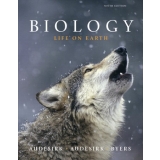Test bank for Biology: Life on Earth 9th 0321598474
$35.00 Original price was: $35.00.$26.50Current price is: $26.50.
Test bank for Biology: Life on Earth 9th 0321598474
Instant download Test bank for Biology: Life on Earth 9th 0321598474 pdf docx epub after payment.

Product details:
- ISBN-10 : 0321598474
- ISBN-13 : 978-0321598479
- Author: Terry and Gerry Audesirk; Bruce E. Byers
The fully revised Biology: Life on Earth, Ninth Edition, has the same friendly writing style appreciated by thousands of students, but with greater emphasis on engaging, real-world applications. New to this edition are “Case Study Continued” sections, which connect a chapter’s case study to relevant biological topics covered in the chapter, and “Have you ever wondered?” features that respond to commonly asked questions from students. Thoroughly revised illustrations and expanded critical thinking questions have been added to each chapter and are supplemented by the powerful new MasteringBiology™ program that helps you make effective use of your study time outside of the classroom.
Table of contents:
An Introduction to Life on Earth
1(18)
Case Study Are Viruses Alive?
1(1)
How Do Scientists Study Life?
2(7)
Life Can Be Studied at Different Levels
2(2)
Scientific Principles Underlie All Scientific Inquiry
4(1)
The Scientific Method is the Basis for Scientific Inquiry
4(2)
Scientific Inquiry Controlled Experiments, Then and Now
6(2)
Communication is Crucial to Science
8(1)
Science is a Human Endeavor
8(1)
Scientific Theories Have Been Thoroughly Tested
8(1)
Evolution: The Unifying Theory of Biology
9(2)
Three Natural Processes Underlie Evolution
9(2)
What are the Characteristics of Living Things?
11(3)
Living Things are Complex, Organized, and Composed of Cells
11(1)
Earth Watch Why Preserve Biodiversity?
12(1)
Living Things Maintain Relatively Constant Internal Conditions Through Homeostasis
13(1)
Living Things Respond to Stimuli
13(1)
Living Things Acquire and Use Materials and Energy
13(1)
Living Things Grow
13(1)
Living Things Reproduce Themselves
13(1)
Living Things, Collectively, Have the Capacity to Evolve
14(1)
Case Study Continued Are Viruses Alive?
14(1)
How Do Scientists Categorize the Diversity of Life?
14(5)
The Domains Bacteria and Archaea Consist of Prokaryotic Cells; the Domain Eukarya is Composed of Eukaryotic Cells
15(1)
Bacteria and Archaea are Mostly Unicellular; Members of the Kingdoms Fungi, Plantae, and Animalia are Nearly All Multicellular
15(1)
Members of the Different Kingdoms Have Different Ways of Acquiring Energy
16(1)
Case Study Continued Are Viruses Alive?
16(1)
Links to Everyday Life Knowledge of Biology Illuminates Life
16(1)
Case Study Revisited Are Viruses Alive?
17(2)
Unit 1 The Life of a Cell
19(124)
Atoms, Molecules, and Life
20(16)
Case Study Crushed by Ice
20(1)
What Are Atoms?
21(3)
Atoms, the Basic Structural Units of Elements, are Composed of Still Smaller Particles
21(2)
Scientific Inquiry Radioactivity in Research
23(1)
How Do Atoms Interact to Form Molecules?
24(4)
Atoms Interact with Other Atoms When There are Vacancies in Their Outermost Electron Shells
24(1)
Free Radicals are Highly Reactive and Can Damage Cells
24(1)
Links to Everyday Life Hmm … What Gas Should I Use to Inflate My Blimp—Or Fill My Car?
25(1)
Chemical Bonds Hold Atoms Together in Molecules
25(1)
Ionic Bonds Form Among Charged Atoms Called Ions
25(1)
Health Watch Might Chocolate Actually Be Good for You?
26(1)
Covalent Bonds Form Between Uncharged Atoms That Share Electrons
27(1)
Hydrogen Bonds are Attractive Forces Between Polar Molecules
27(1)
Why is Water So Important to Life?
28(8)
Water Molecules Attract One Another
28(1)
Water Interacts with Many Other Molecules
29(1)
Case Study Continued Crushed by Ice
30(1)
Water-Based Solutions Can Be Acidic, Basic, or Neutral
30(2)
Water Moderates the Effects of Temperature Changes
32(1)
Case Study Continued Crushed by Ice
33(1)
Water Forms an Unusual Solid: Ice
33(1)
Case Study Revisited Crushed by Ice
33(3)
Biological Molecules
36(19)
Case Study Puzzling Proteins
36(1)
Why is Carbon So Important in Biological Molecules?
37(1)
How are Organic Molecules Synthesized?
37(1)
Biological Polymers are Formed by Removing Water and Split Apart by Adding Water
38(1)
What are Carbohydrates?
38(5)
There are Several Monosaccharides with Slightly Different Structures
39(1)
Disaccharides Consist of Two Single Sugars Linked by Dehydration Synthesis
40(1)
Polysaccharides are Chains of Single Sugars
41(1)
Links to Everyday Life Fake Foods
41(2)
What are Lipids?
43(2)
Oils, Fats, and Waxes are Lipids Containing Only Carbon, Hydrogen, and Oxygen
43(1)
Phospholipids Have Water-Soluble “Heads” and Water-Insoluble “Tails”
44(1)
Steroids Consist of Four Carbon Rings Fused Together
44(1)
What are Proteins?
45(6)
Health Watch Cholesterol, Trans Fats, and Your Heart
46(1)
Proteins are Formed from Chains of Amino Acids
47(1)
Amino Acids are Joined to Form Chains by Dehydration Synthesis
47(1)
A Protein Can Have Up to Four Levels of Structure
48(1)
Case Study Continued Puzzling Proteins
48(2)
A Closer Look At Proteins and Hair Texture
50(1)
The Functions of Proteins are Related to Their Three-Dimensional Structures
51(1)
What are Nucleotides and Nucleic Acids?
51(4)
Nucleotides Act as Energy Carriers and Intracellular Messengers
51(1)
DNA and RNA, the Molecules of Heredity, are Nucleic Acids
51(1)
Case Study Continued Puzzling Proteins
52(1)
Case Study Revisited Puzzling Proteins
52(3)
Cell Structure and Function
55(22)
Case Study Spare Parts for Human Bodies
55(1)
What is the Cell Theory?
56(1)
What are the Basic Attributes of Cells?
56(6)
Cell Function Limits Cell Size
56(1)
All Cells Share Common Features
56(2)
Scientific Inquiry The Search for the Cell
58(2)
Case Study Continued Spare Parts for Human Bodies
60(2)
There are Two Basic Types of Cells: Prokaryotic and Eukaryotic
62(1)
What are the Major Features of Eukaryotic Cells?
62(10)
Some Eukaryotic Cells are Supported by Cell Walls
63(1)
The Cytoskeleton Provides Shape, Support, and Movement
63(1)
Cilia and Flagella Move the Cell Through Fluid or Move Fluid Past the Cell
64(1)
The Nucleus is the Control Center of the Eukaryotic Cell
65(2)
Case Study Continued Spare Parts for Human Bodies
67(1)
Eukaryotic Cytoplasm Includes an Elaborate System of Membranes
67(3)
Vacuoles Serve Many Functions, Including Water Regulation, Support, and Storage
70(1)
Mitochondria Extract Energy from Food Molecules, and Chloroplasts Capture Solar Energy
70(2)
Plants Use Plastids for Storage
72(1)
What are the Major Features of Prokaryotic Cells?
72(5)
Prokaryotic Cells are Relatively Small and Possess Specialized Surface Features
72(1)
Prokaryotic Cells Have Fewer Specialized Structures Within Their Cytoplasm
73(1)
Links to Everyday Life Unwanted Guests
74(1)
Case Study Revisited Spare Parts for Human Bodies
74(3)
Cell Membrane Structure and Function
77(20)
Case Study Vicious Venoms
77(1)
How is the Structure of a Membrane Related to Its Function?
78(4)
Cell Membranes Isolate the Cell Contents While Allowing Communication with the Environment
78(1)
Membranes are “Fluid Mosaics” in Which Proteins Move Within Layers of Lipids
78(1)
The Phospholipid Bilayer is the Fluid Portion of the Membrane
78(2)
A Closer Look At Form, Function, and Phospholipids
80(1)
Case Study Continued Vicious Venoms
81(1)
A Variety of Proteins Form a Mosaic Within the Membrane
81(1)
How Do Substances Move Across Membranes?
82(10)
Molecules in Fluids Move in Response to Gradients
82(1)
Movement Through Membranes Occurs by Passive Transport and Energy-Requiring Transport
83(1)
Passive Transport Includes Simple Diffusion, Facilitated Diffusion, and Osmosis
84(2)
Scientific Inquiry The Discovery of Aquaporins
86(1)
Energy-Requiring Transport Includes Active Transport, Endocytosis, and Exocytosis
87(3)
Exchange of Materials Across Membranes Influences Cell Size and Shape
90(2)
How Do Specialized Junctions Allow Cells to Connect and Communicate?
92(5)
Desmosomes Attach Cells Together
92(1)
Tight Junctions Make Cell Attachments Leakproof
93(1)
Gap Junctions and Plasmodesmata Allow Direct Communication Between Cells
93(1)
Case Study Revisited Vicious Venoms
94(3)
Energy Flow in the Life of a Cell
97(15)
Case Study Energy Unleashed
97(1)
What is Energy?
98(2)
The Laws of Thermodynamics Describe the Basic Properties of Energy
99(1)
Case Study Continued Energy Unleashed
99(1)
Living Things Use the Energy of Sunlight to Create the Low-Entropy Conditions of Life
99(1)
How Does Energy Flow in Chemical Reactions?
100(1)
Exergonic Reactions Release Energy
100(1)
Case Study Continued Energy Unleashed
101(1)
Endergonic Reactions Require a Net Input of Energy
101(1)
How is Energy Transported Within Cells?
101(2)
ATP is the Principal Energy Carrier in Cells
101(1)
Electron Carriers Also Transport Energy Within Cells
102(1)
Coupled Reactions Link Exergonic with Endergonic Reactions
102(1)
How Do Enzymes Promote Biochemical Reactions?
103(2)
At Body Temperatures, Spontaneous Reactions Proceed Too Slowly to Sustain Life
103(1)
Catalysts Reduce Activation Energy
103(1)
Enzymes Are Biological Catalysts
103(2)
How Do Cells Regulate Their Metabolic Reactions
105(7)
Reaction Rates Tend to Increase as Substrate or Enzyme Levels Increase
105(1)
Case Study Continued Energy Unleashed
105(1)
Cells Regulate Enzyme Synthesis
105(1)
Cells Regulate Enzyme Activity
106(1)
Health Watch Lacking an Enzyme Can Lead to Lactose Intolerance or Phenylketonuria
106(1)
Poisons, Drugs, and Environmental Conditions Influence Enzyme Activity
107(2)
Case Study Revisited Energy Unleashed
109(3)
Capturing Solar Energy: Photosynthesis
112(15)
Case Study Did the Dinosaurs Die from Lack of Sunlight?
112(1)
What is Photosynthesis?
113(3)
Leaves and Chloroplasts are Adaptations for Photosynthesis
113(1)
Photosynthesis Consists of the Light Reactions and the Calvin Cycle
114(1)
Case Study Continued Did the Dinosaurs Die from Lack of Sunlight?
115(1)
Light Reactions: How is Light Energy Converted to Chemical Energy?
116(4)
Light is Captured by Pigments in Chloroplasts
116(1)
The Light Reactions Occur in Association with the Thylakoid Membranes
117(3)
The Calvin Cycle: How is Chemical Energy Stored in Sugar Molecules?
120(2)
The Calvin Cycle Captures Carbon Dioxide
120(1)
Case Study Continued Did the Dinosaurs Die from Lack of Sunlight?
120(1)
Carbon Fixed During the Calvin Cycle is Used to Synthesize Sugar
121(1)
Why Do Some Plants Use Alternate Pathways for Carbon Fixation?
122(5)
People also search:
Biology: Life on Earth 9th pdf
Biology: Life on Earth 9th
Biology: Life on Earth
biology life on earth with physiology
history of life on earth biology
how animals survive earth and life science











